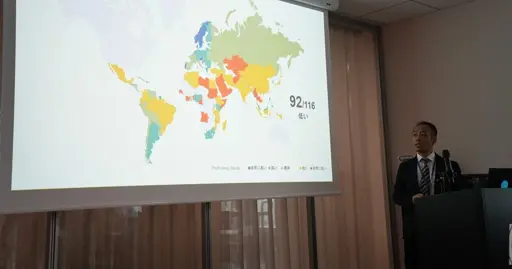Summary
Japan’s English proficiency ranking dropped to 92nd out of 116 countries, the lowest ever recorded.
The decline is attributed to stagnant English proficiency among young people, particularly due to the COVID-19 pandemic.
The Netherlands ranked first, followed by European countries, while the Philippines and Malaysia ranked 22nd and 26th, respectively.



I’m not sure if they’re neatly explained somewhere, but the short of it is that sh, j and ch are “smoother” than the English versiond. They’re literally just s, z and t respectively, with an i next to them and smoothed over for ease of pronunciation because otherwise it’s a pain to say “si” (languages that do have this sound, like English, have ways of coping with this, but Japanese doesn’t). In English the equivalent of this is how drink is actually djrink and two becomes chuu, but anyway the point is that thinking of these three sounds as coping mechanisms rather than independent sounds should help. Listen carefully to a Japanese shi and you’ll hear the remnants of an s in it. You’ll probably have some luck looking these sounds up on YouTube.
W is a bit simpler; it’s just uw instead of a plain W, in the same way the English version lets out a bit of air before the W itself. Just insert a small u before watashi to make it uwatashi and you’ll get pretty close. Again YT should help. BTW to help appreciate the difference, when the Japanese try to emulate the English W sound they add a ho first, as in howaito (white).
My strategy is watch tons of anime (or your Japanese media of choice) with English subtitles. As long as you don’t depend completely on the subtitles and try to listen to the words being said it’s a pretty effective way of learning the language in my experience. Simple manga (or, again, your Japanese written media of choice) also does wonders.
Edit: A bunch of stuff here is wrong, see below.
The stuff about “w” is wrong, but there’s a good reason you would think this. The lip shape for the “w” sound in English and Japanese is different; in English the shape is like English “u”, and in Japanese the shape is like Japanese “u”, but you definitely shouldn’t have an actual “u” sound.
I think, especially considering your comment about ホワイト howaito, that you’re confusing two things. There are English dialects which have two separate “w”-like sounds, one of which is typically written “wh” and the other “w”. (To my ear, this distinctiln also sounds old-fashioned.) In these dialects, “w” as in “water” and “wood” is pronounced like you would expect, whereas “wh” as in “who” and “what” is pronounced somewhat like an “h” sound followed by just-“w” sound. I don’t think the “wh” sound is used for all instances of “w” in any dialect; in fact, most dialects have just the “w” sound.
This is false, they only do this for “wh” sounds (and maybe not even for all of them). Counterexamples to your claim are easy: ウェイトレス weitoresu = waitress, ワット watto = watt, etc.
That… Is all true. I guess I was basically spreading misinformation.